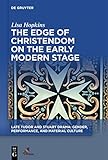The Edge of Christendom on the Early Modern Stage / Lisa Hopkins.
Material type: TextSeries: Late Tudor and Stuart Drama : Gender, Performance, and Material CulturePublisher: Kalamazoo, MI : Medieval Institute Publications, [2022]Copyright date: ©2022Description: 1 online resource (VIII, 250 p.)Content type:
TextSeries: Late Tudor and Stuart Drama : Gender, Performance, and Material CulturePublisher: Kalamazoo, MI : Medieval Institute Publications, [2022]Copyright date: ©2022Description: 1 online resource (VIII, 250 p.)Content type: - 9781501520334
- 9781501514173
- 9781501514159
- 822.309 23/eng/20220415
- online - DeGruyter
- Issued also in print.
| Item type | Current library | Call number | URL | Status | Notes | Barcode | |
|---|---|---|---|---|---|---|---|
 eBook
eBook
|
Biblioteca "Angelicum" Pont. Univ. S.Tommaso d'Aquino Nuvola online | online - DeGruyter (Browse shelf(Opens below)) | Online access | Not for loan (Accesso limitato) | Accesso per gli utenti autorizzati / Access for authorized users | (dgr)9781501514159 |
Browsing Biblioteca "Angelicum" Pont. Univ. S.Tommaso d'Aquino shelves, Shelving location: Nuvola online Close shelf browser (Hides shelf browser)

|

|

|

|

|

|

|
||
| online - DeGruyter The Vikings Reimagined : Reception, Recovery, Engagement / | online - DeGruyter Hysteria, Perversion, and Paranoia in “The Canterbury Tales” : “Wild” Analysis and the Symptomatic Storyteller / | online - DeGruyter Reading the Old Norse-Icelandic “Maríu saga” in Its Manuscript Contexts / | online - DeGruyter The Edge of Christendom on the Early Modern Stage / | online - DeGruyter The Development of Education in Medieval Iceland / | online - DeGruyter Roman Women in Shakespeare and His Contemporaries / | online - DeGruyter Negotiating Boundaries in Medieval Literature and Culture : Essays on Marginality, Difference, and Reading Practices in Honor of Thomas Hahn / |
Frontmatter -- Contents -- Acknowledgements -- Introduction -- Part One: The Edge and the Centre -- Chapter 1 “All places shall be hell that are not heaven”: The Edge of Rome -- 2 Beautiful Polecats: The Living and the Dead in Julius Caesar -- 3 Danger and Demarcation in Massinger -- Part Two: Edges Abroad -- Chapter 4 “Having passed Armenian deserts now”: Marlowe’s Tamburlaine the Great -- 5 Bears and Fairies: A Midsummer Night’s Dream and Twelfth Night -- 6 The Last Plays and the Edges of Christendom -- 7 The Politics of the Rose: English Histories and Foreign Flowers -- Part Three: Edges at Home -- Chapter 8 North by North-West: The Danelaw and the Edge of Christendom -- 9 Let the Right One In: Edges of Christendom in Cavendish-Talbot Houses -- Conclusion -- Works Cited -- Index of Place Names, Authors, and Works
restricted access online access with authorization star
http://purl.org/coar/access_right/c_16ec
Throughout the sixteenth and seventeenth centuries, the edges of Europe were under pressure from the Ottoman Turks. This book explores how Shakespeare and his contemporaries represented places where Christians came up against Turks, including Malta, Tunis, Hungary, and Armenia. Some forms of Christianity itself might seem alien, so the book also considers the interface between traditional Catholicism, new forms of Protestantism, and Greek and Russian orthodoxy. But it also finds that the concept of Christendom was under threat in other places, some much nearer to home. Edges of Christendom could be found in areas that were or had been pagan, such as Rome itself and the Danelaw, which once covered northern England; they could even be found in English homes and gardens, where imported foreign flowers and exotic new ingredients challenged the concept of what was native and natural.
Issued also in print.
Mode of access: Internet via World Wide Web.
In English.
Description based on online resource; title from PDF title page (publisher's Web site, viewed 25. Jun 2024)


